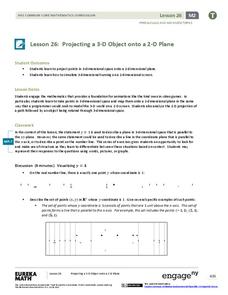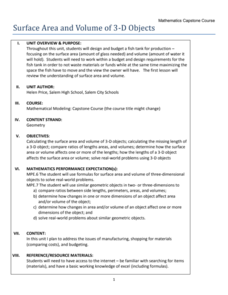Illustrative Mathematics
3-D Shape Sort
From the apple on your desk and the coffee cup in your hand, to the cabinets along the classroom wall, basic three-dimensional shapes are found everywhere in the world around us. Introduce young mathematicians to the these common figures...
EngageNY
Projecting a 3-D Object onto a 2-D Plane
Teach how graphic designers can use mathematics to represent three-dimensional movement on a two-dimensional television surface. Pupils use matrices, vectors, and transformations to model rotational movement. Their exploration involves...
Curated OER
3-D Figures Part 1
Elementary schoolers explore 3-D shapes. They transition from thinking of shapes as only 2-D. Pupils read Cinderella as a launching activity for their upcoming adventure, and explore a new world of 3-D shapes in this introductory lesson.
Mathematics Assessment Project
Representing 3-D Objects in 2-D
How does the shape of the surface of water in a container change as water leaks out? After tackling this question, learners take part in a similar activity with more complex figures.
North Carolina State University
Shapes
Expose youngsters to 3-D objects in a hands-on learning activity involving marshmallows and toothpicks. Engage your young mathematicians by introducing them to 3-D shapes by means of a story book. Explore 3-D shapes by manipulating...
Mathed Up!
Nets, Plans, and Elevations
A dimensional resource teaches viewers to recognize 2-D views of 3-D objects and how to match nets with their 3-D figures. Individuals draw different views of three-dimensional objects including views from the front, side elevations and...
Curated OER
Math - "Solid Shapes" - Comparing 3-D Objects
In this geometry worksheet, students learn about 3-D objects and how to describe them. They then answer 10 questions using the information they learned. The answers are on the last page.
Curated OER
Visualize 3-D Objects and Make Nets of Common Solids
In this 3-D objects and common solids worksheet, students cut out and count the number of faces on several different types of boxes and make a cuboid from straws or a card. Students fill out 4 different categories involving 5 different...
Curated OER
Recognizing 3-Dimensional Shapes
Three-dimensional shapes are all around us; expose young geometers to this concept as they focus on identifying four figures: cube, prism, sphere, and pyramid. Learners begin by matching four objects to the shape each resembles (i.e. a...
Radford University
Surface Area and Volume of 3-D Objects
Don't let the class tank the project. After reviewing formulas for surface area and volume, pupils design fish tanks that maximize volume. They research cost of materials online and must meet a budgetary constraint when creating their...
Curated OER
Geometry Vases: Ceramics Lesson
Geometric shapes are used in math and in art. Learners discuss the various names, dimensions, and attributes of geometric shapes, then apply that knowledge to design a vase. They use 3-D shapes to make a cubist-style vase out of clay.
Curated OER
3-D Cubes
Students investigate cubes. In this geometric solids instructional activity, students review geometric concepts previously taught, then logon to a computer game in which they find cube figures and identify the shadow of hidden cubes.
Curated OER
Analyzing 3-D Shapes and 2-D Representations
Students can analyze 3-D objects better with actual physical models and by also drawing 2-D representations of them.
Curated OER
2-D and 3-D Presents at Pedro's Party
Fifth graders draw 2-D and 3-D shapes. They sketch and label geometric figures with correct terminology, then explore parallel and perpendicular lines. Pupils sort and classify shapes drawn.
Radford University
2 and 3 Dimensional Shapes
Take a similar approach to three dimensions. Pupils develop the relationship between areas of similar objects and see how they relate to the ratio of the sides. Building upon area formulas, small groups put together volume formulas for...
Curated OER
What Shape Is That Object?
Before begining this instructional activity you will need to clarify if learners are to write the 2-D, 3-D, or both version of each shape shown. They are to write the name of the shape they see. Some may be cones, spheres, or pyramids...
American Museum of Natural History
Thinking in the Three Dimensions
Discover different dimensions with paper folding. Pupils first read about zero, one, two, and three dimensions, and then learn about the fourth dimension, time. They then use origami to create models of shapes in three dimensions and use...
Curated OER
Write the 3-D Shape's Name, Part 2
Geometry can be fun when you know the shapes! Twelve pictures of geometric shapes, including cones, pyramids, and spheres, prompt first graders to write the name of each shape in the space provided. Use the activity as a quiz or homework...
Curated OER
Three-Dimensional Objects
Fourth graders view and identify three-dimensional figures. They analyze and discuss various figures, build three-dimensional figures, and complete various worksheets and worksheet discussion questions.
Curated OER
Name the 3 Dimensional Shapes of the Objects
Here are six solid figures for learners to identify. The names are listed along the left side and the shapes pictured on the right. Each shape is shown as a familiar object instead of just a drawing. Figures include a cylinder,...
Curated OER
The Direct Object
What exactly is a direct object? Use this resource to introduce direct objects to your middle and early high school classrooms. The section at the top explains the part of speech, and then there are 20 sentences below for learners to...
Curated OER
Worksheet 2-Direct Object Pronouns
As your Spanish speakers build their language skills, it's important for them to know the purpose of direct object pronouns and how to use them. There are two exercises provided here; in the first, the learner has to write the correct...
Curated OER
Indirect Object Pronouns
Beginning Spanish language learners review indirect object pronouns with this resource. Pupils choose the indirect object pronoun that completes the sentence the best.
Mathematics Vision Project
Module 5: Modeling with Geometry
Solids come in many shapes and sizes. Using geometry, scholars create two-dimensional cross-sections of various three-dimensional objects. They develop the lesson further by finding the volume of solids. The module then shifts to finding...
Other popular searches
- Visualizing 3 D Objects
- 3 D Objects Activities
- 2 and 3 D Objects
- 3 D Objects Cones
- Comparing 3 D Objects
- Making 3 D Objects
- Geometry 3 D Objects
- Slicing 3 D Objects

























